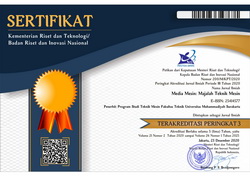THE EFFECT OF CRITICAL TRACTION IN COHESIVE ZONE MODEL FOR FATIGUE CRACK GROWTH RETARDATIO
Hendery Dahlan(1*)(1) Universitas Andalas
(*) Corresponding Author
Abstract
Full Text:
PDFReferences
Dugdale, D.S. 1960, Yielding of Steel Sheets Containing Slits. Journal of the Mechanics and Physics of Solids, 8, p. 100-108.
Barenblatt, G.I., 1962, The mathematical theory of equilibrium cracks in brittle fracture,. Advance Applied Mechanics, 7, p. 55-129.
Hillerborg, A., Modeer, M., Petersson, P.E.,1976, Analysis of crack formation and crack growth in concrete by means of fracture mechanics and finite element. Cement Concrete, 6, p. 773-781.
Siegmund, T., Needleman, A.,1997, A numerical study of dynamic crack growth in elastic-vicoplastic solids. Int. J. Solids Structure, 34, p. 769-787.
Needleman, A.,1990, An analysis of tensile decohesion along an interface. J. Mech. Phys. Solids, 38, p. 289-324. [6] Ortiz, M., Pandolfi, A., 1999, Finite-deformation irreversible cohesive elements for three-dimensional crack propagation analysis. Int. J. Numer. Meth. Eng., 44, p. 12671282.
Nguyen, O., Repetto, E. A., Ortiz, M. and Radovitzky, R. A., 2001, A cohesive model of fatigue crack growth. International Journal Fracture, 110, p. 351-369.
de-Andres, A., Perez, J. L., Ortiz, M., 1999, Elastoplastic Finite element analysis of three dimensional fatigue crack growth in aluminum shafts subjected to axial loading. International Journal of Solids and Structures, 36, p. 2231-2258.
Roe, K., L., Siegmund, T., 2003, an Irreversible Cohesive Zone Model for Interface Fatigue Crack Growth Simulation. Engineering Fracture Mechanics, 70, p.209-232. [10] Siegmund, T., 2004, A numerical study of transient fatigue crack growth by use of an irreversible cohesive zone model. International Journal of Fatigue, 26, p. 929-939. [11] Mohanty, J.R., Verma, B. B., Ray, P. K., 2009, Prediction of fatigue crack growth and residual life using an exponential model: Part II (mode-I overload induced retardation). International Journal of Fatigue, 31, p. 425–432.
Kim, K.S., Kim, S.C., Shim, C.S., & Park, J.Y., 2004, A studying on the effect of overload Ratio on Fatigue Crack Growth. Key Engineering Materials, p. 1159-1168.
Elber, W., 1970, Fatigue crack closure under cyclic tension. Journal Engineering Fracture. Mechanics, 2, p. 37-45. [14] Laverne, J., 2012, CZM cohesive behavior laws and load control, R7.02.11, Code Aster Documentation
Article Metrics
Abstract view(s): 417 time(s)PDF: 352 time(s)
Refbacks
- There are currently no refbacks.








